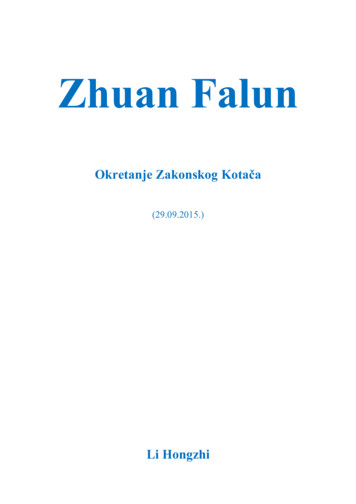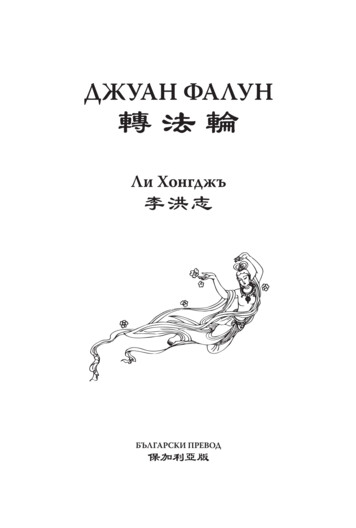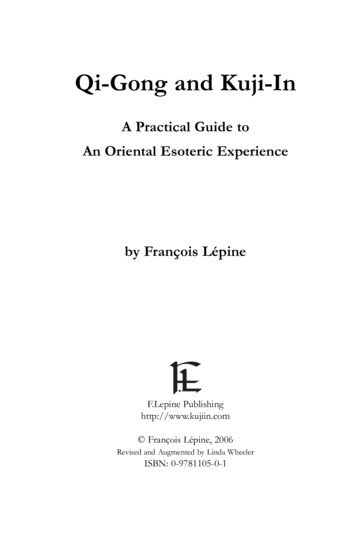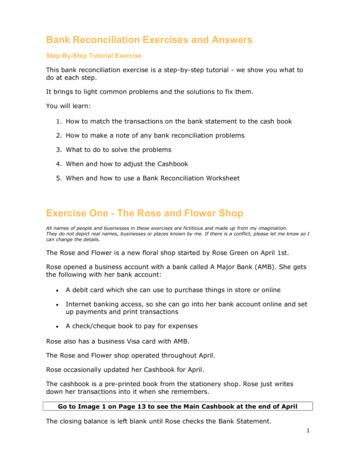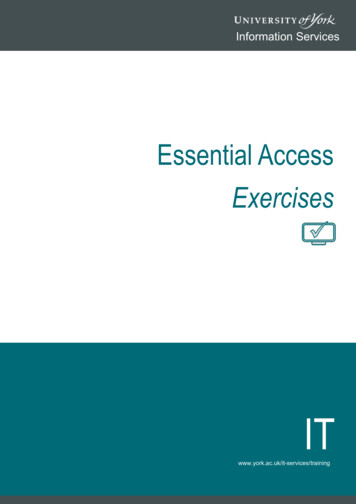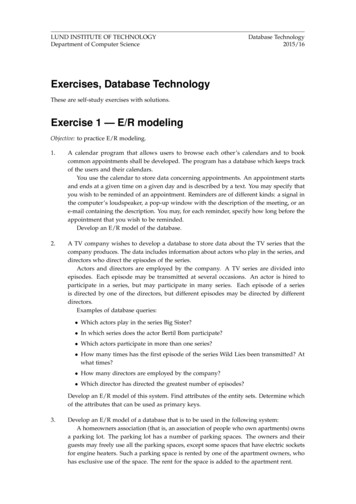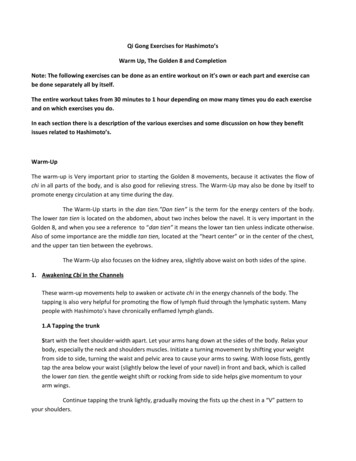
Transcription
Qi Gong Exercises for Hashimoto’sWarm Up, The Golden 8 and CompletionNote: The following exercises can be done as an entire workout on it’s own or each part and exercise canbe done separately all by itself.The entire workout takes from 30 minutes to 1 hour depending on mow many times you do each exerciseand on which exercises you do.In each section there is a description of the various exercises and some discussion on how they benefitissues related to Hashimoto’s.Warm-UpThe warm-up is Very important prior to starting the Golden 8 movements, because it activates the flow ofchi in all parts of the body, and is also good for relieving stress. The Warm-Up may also be done by itself topromote energy circulation at any time during the day.The Warm-Up starts in the dan tien.”Dan tien” is the term for the energy centers of the body.The lower tan tien is located on the abdomen, about two inches below the navel. It is very important in theGolden 8, and when you see a reference to “dan tien” it means the lower tan tien unless indicate otherwise.Also of some importance are the middle tan tien, located at the “heart center” or in the center of the chest,and the upper tan tien between the eyebrows.The Warm-Up also focuses on the kidney area, slightly above waist on both sides of the spine.1. Awakening Cbi in the ChannelsThese warm-up movements help to awaken or activate chi in the energy channels of the body. Thetapping is also very helpful for promoting the flow of lymph fluid through the lymphatic system. Manypeople with Hashimoto’s have chronically enflamed lymph glands.1.A Tapping the trunkStart with the feet shoulder-width apart. Let your arms hang down at the sides of the body. Relax yourbody, especially the neck and shoulders muscles. Initiate a turning movement by shifting your weightfrom side to side, turning the waist and pelvic area to cause your arms to swing. With loose fists, gentlytap the area below your waist (slightly below the level of your navel) in front and back, which is calledthe lower tan tien. the gentle weight shift or rocking from side to side helps give momentum to yourarm wings.Continue tapping the trunk lightly, gradually moving the fists up the chest in a “V” pattern toyour shoulders.
Gradually down the same path, returning to the lower tan tien. Repeat a few times.BREATHING: Breathe deeply and naturally.1.B Tapping the trunk and armsStart with feet shoulder-width apart. Make a loose fist with the right hand, lift and extend the left arm,and tap from the level of the navel to under the arm, up the shoulder to the neck, down the shoulder,down the inside of the arm to the palm, back up outside of the arm, and in along the shoulder to theneck.Repeat on the other side with the left hand and right arm.BREATHING: Breathe deeply and naturally.1.C Tapping the back and legsStart with the feet wide apart (the width of the horse stance, but with legs straight). Making loose fistswith the hands, bend forward at the waist and tap with the backs of the fists in circles over the kidneys,moving up the spine, circling a few times.Continue tapping with the insides of the fists along the sides of the buttocks, down the outsideof the legs to the ankles, switch to the inside of the ankles and tap up the inside of the legs to theconnection of the legs to the trunk (the ligaments on each side of the crotch).Bring the feet into shoulder-width apart, and tap with the inside of the loose fists against theconnection of the legs to the trunk, alternating with legs straight and legs bent a few times, giving an upand down motion while tapping.BREATHING: Deep and natural.1.D Swinging the arms back and jumping upStart with feet shoulder-width apart. Freely swing the arms from front to back until you find the point ofnatural resistance in back, and then let them swing to the front again.After several swings, to enhance the movement, bend the knees slightly and lift the heels as thearms swing back and up.After several more swings, jump up as the arms swing back and up. Feel as though themomentum of your arms swinging back carries you up. Repeat, going progressively higher each time.Then, gradually jump less and less high, slow down and gradually stop swinging the arms,bending the knees and lifting the heels, and return to a normal standing position.BREATHING: Inhale when arms swing back and up.2. Loosening and opening up the jointsThese warm-up movements loosen and open up the major joints of the body, allowing chi to passthrough them more easily. When done as part of the Golden 8, these movements work with the chi inyour channels and therefore have more specific benefits, as described later. Several optionalmovements are also included in the Warm-Up to open up the remaining joints of the body.2.A Turning the neckStart with heels together and hands together. Men place right hand underneath left hand, women placeleft hand underneath right hand. Place the thumb of the upper hand inside the thumb of the lowerhand, and the first joint of one of the fingers of the upper hand over the side of the big knuckle of thelittle finger on the lower hand.
Keeping the neck relaxed, slightly bend the upper body and shoulders to allow gravity to roll thehead gently and slowly to the left, back to the right, and front in a circle, repeating several times.Reverse direction when the head is bent forward, and repeat.BREATHING: Inhale as your head circles to the back, exhale as it circles to the front.Some of the turning warm ups are optional, but are very helpful if you have joint pain and jointrelated issues. If this is the case, do them slowly and gently.2.B (optional) Turning the shouldersKeeping the arms relaxed, lift the left shoulder and turn the waist to roll the shoulder from front to back,repeating a few times. Reverse, lifting the shoulder back to front, repeating a few more times.Repeat on the other side.NOTE: As an alternative, big shoulder rotations can be done. Lift the arm on the left side straightup above the shoulder and rotate it down in front and up in back, circling a few times. Reverse direction,circling a few more times. Repeat on the other side.BREATHING: Inhale when circling up and exhale when circling down.2.C (optional) Turning the elbowsPlace the right hand over the elbow area in front of the left arm hanging down at the side. Keeping thehand loosely over the elbow are, bend the left arm at the elbow, turning it up toward the body on theinside of the right arm, and then circle the left forearm back down away from the body. Repeat a fewtimes.Reverse direction, bending the left arm at the elbow and turning it up away from the body andback down towards the body to circle inside the right arm.Repeat on the other side.BREATHING: Inhale when circling up and exhale when circling down.2.D (optional) Turning the wristsKeeping the arms relaxed and hanging down at the sides, turn the hands around the wrist on each side,a few times toward the trunk in front, then reverse for a few more times away from the trunk in front.Gently shake the hands, then the hands and lower arms, then the hands and lower and upperarms.NOTE: As an alternative, clasp the hands with fingers interlaced and trace a “figure eight” infront of the body. Try to get a full range of motion when turning and bending the wrists. After repeatinga few times, reverse direction for a few more times.BREATHING: Breathe deeply and naturally.2.E (optional) Turning the waistStart with feet wide apart (the width of a horse stance, but with legs straight). Place the hands on thewaist on each side, and bend forward at the waist. Keeping the hands in place and turning at the waist,circle the upper body around to the left, lean back, to the right, and bend forward again, repeating a fewtimes. When bent forward, reverse direction and repeat a few more times, then straighten up.BREATHING: Inhale when circling to the back, exhale when circling to the front.2.F Turning the hips
Start with heels together, or farther apart if necessary for balance. Place the palms of the hands over thekidneys and rub them a few times to warm them up.Keeping the palms over the kidneys, and the head upright and over the feet, push the hipsforward, then to the left, back, to the right, and forward to make a complete rotation. Repeat severaltimes.Reverse direction and repeat several more times in the opposite direction, then straighten up.BREATHING: Exhale as the hips circle forward, inhale back.2.G Turning the kneesStart with feet together. Bend forward at the waist and rest the hands on the knees. Lightly rub theknees to warm them. Make a circle by bending the knees to the left, then in front and to the right, andthen straighten them. Repeat several times. Reverse the direction of the circle and repeat several moretimes.Next, make circles by bending the knees forward and separating them, moving them out to eachside, and circling back as you straighten them. Repeat several more times.Reverse the direction of the circles and repeat.BREATHING: Exhale when knees bend down, inhale when straightening up.2.H Turning the anklesLift the left foot. Rotate it at the ankle several times on one direction, then in the other. Alternatepointing and flexing the foot, then shake it to loosen the ankle joint. Repeat for the other foot.NOTE: An alternative to loosen the ankle joint is to place the left foot at an angle behind you,ball of the foot on the ground and heel in the air. Turn that foot’s ankle in big circles, then reverse thedirection of the circles. Repeat on the other side.BREATHING: Deep and natural.The Golden 8The Golden 8 was first taught to me by Merle Morgan –Drennan in a Medical Qi Gong class atEmperor’s College in Santa Monica, CA. Merle is a student of Master Hong Liu who taught her theform. He is a Qi Gong master and his story is chronicled in the book, The Healing Art of Qi Gong.I know and practice many different qi gong forms and exercises, but I like the Golden 8 because of it’ssimplicity and it is quite easy to learn.As a general recommendation, I suggest doing the exercises a minimum of 3 times once per day. If youhave issues in a particular area, it is recommended that you increase the number to 2 or 3 times a day.
The Golden 8To Begin: The Natural Standing Form:Each form of the Golden 8 begins with the Natural Standing Form. To do this stand with your feetshoulder width apart and your back straight and lengthened slightly as if someone were pulling up on astring at the top of your head. Keep your tongue lightly pressed against the roof of your mouth, andyour chin slightly tucked in. Breathe into your lower Dan Tien.For more advanced practice, put your focus at the top most point of your head (Du 20) and slowly bring your focusdown the front of your face and torso, and down your legs and our the tips of your toes.Visualize the energy descending and taking with it any negative thoughts or feelings you might have. Repeat thisdown the back of your head and body and out your heels. Finally, do it again down the sides of your body in threesegments. Firstly, down the side of your head, the sides of your arms and out your fingers. Then down the inside ofyour arm and out your fingers. Lastly, beginning at your armpits and down the sides of your body and our yourtoes.FromThe Healing Art of Qi GongBy Master Hong Liu
The Golden 8Form #1Reach for Happiness“After a night of sleep, people should get up early They should loosen their hair and slow down theirmovements. By these means they can fulfill their wish to live healthfully.”Purpose and Effect: In Chinese medicine, the lungs are the most important organs for creating andsustaining vitality. When we inhale, we take in oxygen and Qi, both of which are vital to our existence.That is why the lung exercise come first in Qi Gong practice. This exercise has its origin in a famousBhudda statue, he is portrayed with his arms above his head, just as in the exercise.The lungs and the large intestines in Chinese medicine comprise the metal element. They are pairedorgans. The one thing unifying them is the immune system. Both the lungs and the large intestines havean enormous number of lymph glands and immune tissue and cells in and around them.Working on healing these areas can have tremendous benefit for calming, regulating and balancing theimmune system. This is very important for people with Hashimoto’s.This exercise is also good for digestive problems; heart, lung, spine, or back problems; and a stiffneck and eye problems. It benefits all three Jiaos.It exercises the entire body through stretching and breathing, also bringing oxygen to the brainfor greater alertness. Scientific experiments have shown that breathing with arms above the headincreases lung volume. This exercise decreases the pressure of the internal organs on the heart andincreases venous circulation and blood flow back to the heart. It also massages and tones the internalorgans.When you lock your fingers and push upward, it adjusts and balances your muscles, tendons,skeletal system, nerves, and spine. When you lower your hands and exhale, you are expelling wasteenergy and relieving fatigue, at the same time, the abdominal muscles and the diaphragm relax,improving circulation to the abdominal area.How to Begin: from the Natural Standing Form, move your left foot out so that your feet are shoulderwidth apart, hands hang relaxed at your sides (a).As you inhale, gracefully sweep your hands out to your sides, to the front, and then let themsettle somewhat in front of the top of your lower Dan Tien, which is located just below your navel. Yourpalms should be facing up, with the fingers of each hand pointing toward each other (b). As you sweepyour hands, imagine that you are gathering up energy and creating a delicate yet powerful ball ofenergy. Make sure your armpits are open the entire time so the energy flow is not impeded.Raise your hands, lifting the energy ball very lightly and steadily up the front
Qi Gong Exercises for Hashimoto’s . Warm Up, The Golden 8 and Completion . Note: The following exercises can be done as an entire workout on it’s own or each part and exercise can be done separately all by itself. The entire workout takes from 30 minutes to 1 hour depending on mow many times you do each exercise and on which exercises you do. In each section there is a description of the .File Size: 712KBPage Count: 23People also search fortai chi warm up videotai chi warm up exercisetai chi warm up exercisestai chi warm up movementsqigong warm up exercisetai chi warm up routines
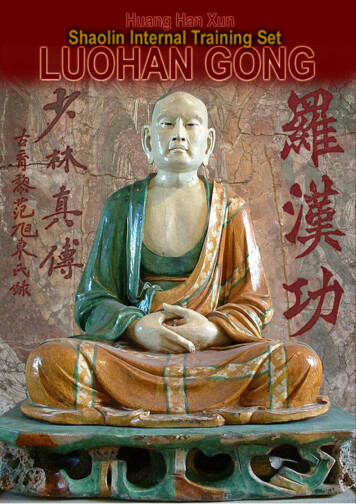
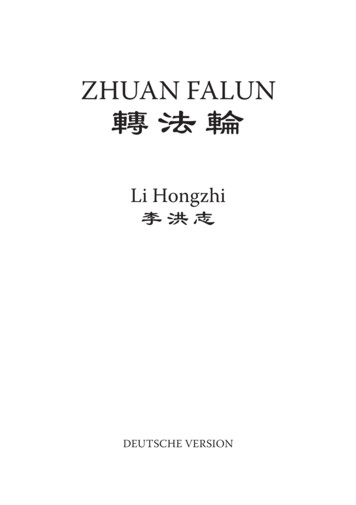
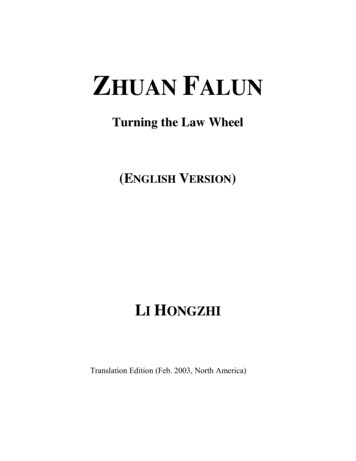
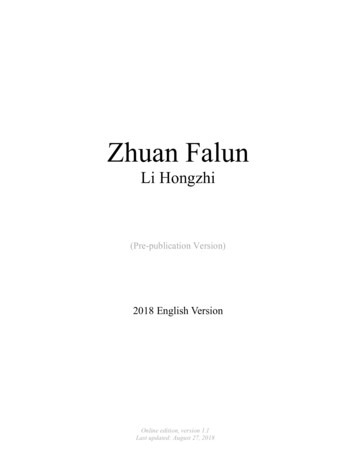
![ebZ 24] 2015 - Falun Gong](/img/6/zhuanfalun-hindi.jpg)
